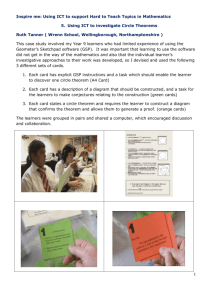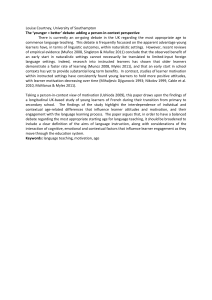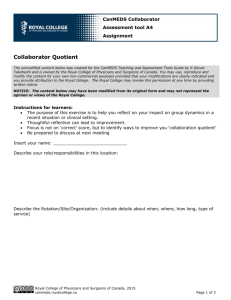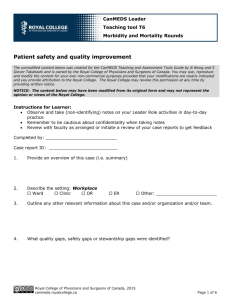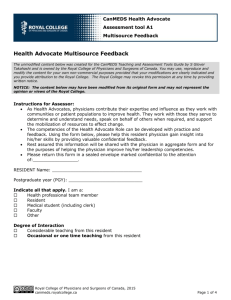MS Word
advertisement
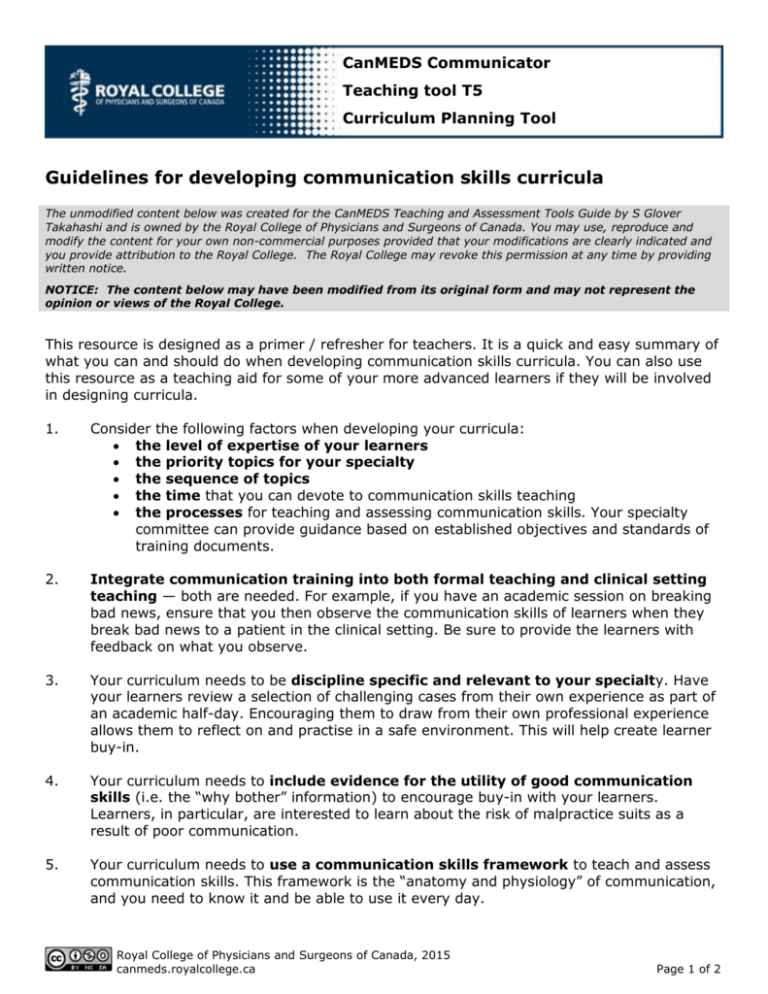
CanMEDS Communicator Teaching tool T5 Curriculum Planning Tool Guidelines for developing communication skills curricula The unmodified content below was created for the CanMEDS Teaching and Assessment Tools Guide by S Glover Takahashi and is owned by the Royal College of Physicians and Surgeons of Canada. You may use, reproduce and modify the content for your own non-commercial purposes provided that your modifications are clearly indicated and you provide attribution to the Royal College. The Royal College may revoke this permission at any time by providing written notice. NOTICE: The content below may have been modified from its original form and may not represent the opinion or views of the Royal College. This resource is designed as a primer / refresher for teachers. It is a quick and easy summary of what you can and should do when developing communication skills curricula. You can also use this resource as a teaching aid for some of your more advanced learners if they will be involved in designing curricula. 1. Consider the following factors when developing your curricula: the level of expertise of your learners the priority topics for your specialty the sequence of topics the time that you can devote to communication skills teaching the processes for teaching and assessing communication skills. Your specialty committee can provide guidance based on established objectives and standards of training documents. 2. Integrate communication training into both formal teaching and clinical setting teaching — both are needed. For example, if you have an academic session on breaking bad news, ensure that you then observe the communication skills of learners when they break bad news to a patient in the clinical setting. Be sure to provide the learners with feedback on what you observe. 3. Your curriculum needs to be discipline specific and relevant to your specialty. Have your learners review a selection of challenging cases from their own experience as part of an academic half-day. Encouraging them to draw from their own professional experience allows them to reflect on and practise in a safe environment. This will help create learner buy-in. 4. Your curriculum needs to include evidence for the utility of good communication skills (i.e. the “why bother” information) to encourage buy-in with your learners. Learners, in particular, are interested to learn about the risk of malpractice suits as a result of poor communication. 5. Your curriculum needs to use a communication skills framework to teach and assess communication skills. This framework is the “anatomy and physiology” of communication, and you need to know it and be able to use it every day. Royal College of Physicians and Surgeons of Canada, 2015 canmeds.royalcollege.ca Page 1 of 2 CanMEDS Teaching and Assessment Tools Guide Communicator teaching tool T5 6. Your curriculum needs to delineate the difference between content skills (what to ask the patient) and process skills (how to ask the patient). Both are essential to effective communication. Often learners struggle with communication process skills because they have a weak knowledge base. Ensure they know what to ask, before focusing on how they ask. 7. Your curriculum needs to teach process skills before it addresses special topics skills. This means you should help your residents develop the process skills for building relationships and for explanation and planning before you attempt to teach breaking bad news, which is a special type of explanation and planning. 8. Your curriculum needs to teach the various components of communication skills more than once. Communication skills need to be rehearsed, reiterated, repeated, and refined, with feedback along the way. 9. Your curriculum needs to emphasize direct observation of learners with a communication skills framework, as it remains the best method for teaching and assessing communication skills. Consider using videotaped recordings of clinical interactions so that learners can review nuances of non-verbal communication skills. Your curriculum can also include: OSCE with or without video Multisource feedback with feedback providers primed before the encounter Portfolios to demonstrate growth in practice 10. Observe your learners communicating with patients and families at every opportunity and provide feedback using a communication skills framework as a guide. You can choose to focus on one aspect of communication just as you would when assessing a learner’s knee examination (i.e. did the learner use plain language or medical jargon when giving information to the patient). You may not always have time to give feedback on the entire knee examination, but you can give feedback on hand placement for the Lachman test for anterior cruciate ligament laxity. When providing feedback, focus on the learner’s intent and outcome – what did the learner intend to do and what actually happened. If the outcome was unexpected, what could the learner do differently next time. 11. Identify one or more leads (i.e. champions) for the teaching and assessment of the Communicator Role in your program. The lead(s) can support your program. 12. Share the load. Consider liaising with other similar specialties to share some of the communication skills teaching within your formal curriculum (e.g. subspecialties in your department). Royal College of Physicians and Surgeons of Canada, 2015 canmeds.royalcollege.ca Page 2 of 2







